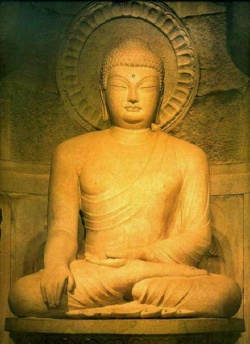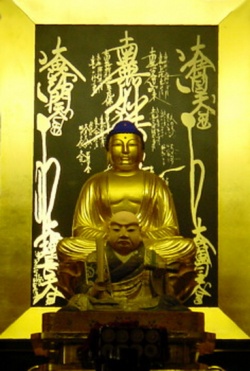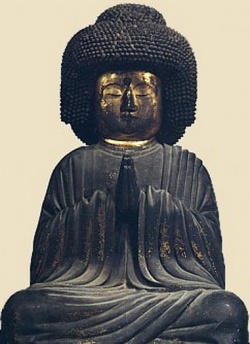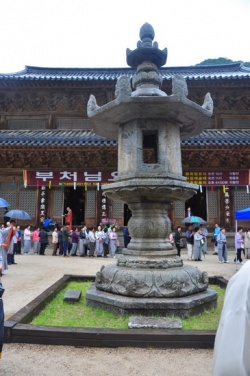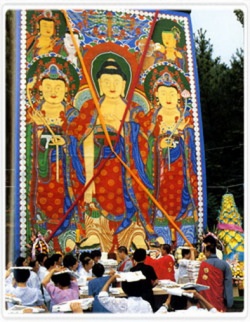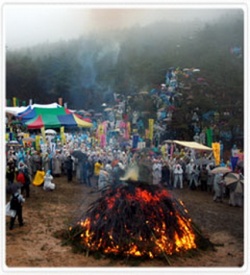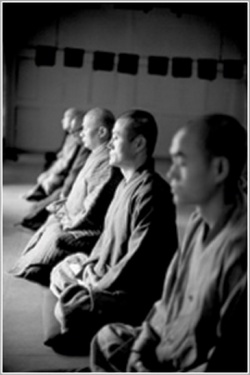Sakyamuni Buddha
Click here to see other articles relating to word Sakyamuni Buddha
A small but noble pantheon of divinities symbolizing Buddhist philosophy and aestheticism, Seokguram is a structure of sublime beauty culminating religious belief, science and fine arts which flowered in the golden age of Asian art
Overlooking the East Sea far ahead beyond the mountain ridges from the southeastern tip of the Korean Peninsula, Seokguram stands as a proud testimony to Korea's brilliant tradition of classical Buddhist sculpture. A small but noble pantheon of divinities symbolizing Buddhist philosophy and aestheticism, the eighth-century cave temple is a structure of sublime beauty culminating religious belief, science and fine arts which flowered in the golden age of Asian art. Seokguram is located near the summit of Mt. Tohamsan, east of the historic city of Gyeongju, capital of the Silla dynasty (57B.C.-A.D.935)
It is reached after an hour-long walk up a steep, winding mountain path over some 4km from Bulguksa, another famous temple dating to the eighth century when Silla was at the peak of its strength. The capital of Silla rivalled in splendor the Dang capital of Jangan and its culture shared in the international character of Dang at this time when all of East Asia enjoyed unprecedented peace and prosperity. Buddhism first reached Korea in the fourth century through China but it truly flowered only after the court of Silla officially recognized it as the state religion.
After Silla unified the peninsula in the mid-seventh century by conquering the rival states of Goguryeo and Baekje, Buddhism not only served a religious function but was looked upon as a protective force. Temples of magnificent scale were erected in and around Gyeongju as they were regarded as a supernatural defense against external threats and bastions of national consciousness. According to the scant historical records available today, both Seokguram and Bulguksa, the two supreme accomplishments of Silla Buddhist architecture, were built under the supervision of Kim Dae-seong, who came from the royal family and served as prime minister under the reign of King Gyeongdeok.
The construction began in 742, the year after Kim resigned from his top position in court. He died in 774 without seeing the completion of the historic projects several years later under the reign of King Hyegong. As a complement to Bulguksa, which was dedicated to the present generation, the granite temple of Seokguram is said to have been intended to honor those who had been Kim's parents in his previous life. Whoever the patron or whatever the motivation, Seokguram was apparently designed as a private chapel for royalty considering its scale, philosophical depth and aesthetic standard, whereas Bulguksa, a grand complex of various worship halls and pagodas, was intended as a state monastery to serve the public.
Too small and cozy to have been conceived as a place for congregation in spite of the enormous resources required for its construction, the grotto shrine represents a pinnacle of religious sculpture not only in Korea but in all of East Asia.
One of Korea's most popular tourist destinations drawing thousands of visitors from home and abroad daily, Seokguram recalls the long journey Buddhism made from its homeland of India through central Asia and China to Korea. A gem of ancient Buddhist architecture punctuating the eastern terminal of the Silk Road, the shrine testifies to the enthusiasm and sacrifice of early Korean monk pilgrims who risked their lives to experience firsthand the exotic traditions of their faith in the far off land of India. Buddhist grottos are generally believed to have originated in ancient India.
They are divided largely into two Kinds according to form and purpose: caitya, literally a "sanctuary" or a hall containing a sacred object to be worshipped such as a small stupa or a Buddha image; and vihara, a monastery or shelter for monks, often with chapels for images or a stupa placed in the central court which also served as a place for instruction.
Grottos in th caitya style were later adopted by the chinese in the hundreds of caves stretching over a mile along the cliffs of Dunhuang and the sandstone hills of Yungang. Seokguram, with a rectangular antechamber leading to a circular domed main chamber, resembles ancient Indian cave temples.
Though inspired by the cave temples of ancient India and China, Seokguram differs in construction to its prototypes which were mostly built by digging into hillsides and carving on natural rocks. korea's topographical features comprising solid rock beds probably made it impossible to import the idea of the sculptors of Karle or Ajanta, who carved thousands of figures, stupas and apse ends out of the soft conglomerate rock and clay. Instead, an incredible artificial cave was assembled with granite on the heights of a mountain some 750meters above sea level, an architectural technique without precedent the world over.
Apex of Korean Buddhist Sculpture
Highlighted by the majestic seated Buddha with a serene, all-knowing expression as the primary object of worship, Seokguram enshrines an impressive assembly of 40 different divinities embodying various aspects of Buddhist teaching. The grotto chapel, in spite of the diversity of the icons ensconced, has a unique feeling of peace and unity resulting in an intense spiritual impression. The prominent skill for handling solid granite aside, modern scientists investigating the source of this rare sensation of sacred harmony discovered that the Silla architects employed the geometric theories of the golden rectangle and symmetry. Seokguram is meticulously designed to guide the faithful into the holy and of the Buddha, a mysterious spiritual journey to the realm of nirvana in a limited span of time and space. In ancient times when there was no transportation, everybody was supposed to walk up the rugged, serpentine mountain path. The journey was to begin at the foot of Mt.Tohamsan which was considered a holy mountain by the people of Silla, or, symbolically, it begin from Bulguksa which straddles the mountain's western midslope. After climbing up the mountain for an hour or so, the pilgrim was to quench his thirst with the icy cold water gushing up from a fountain in front of the shrine Passing the arched entrance into the rectangular antechamber and proceeding through a slightly narrower corridor, their walls decorated with a legion of bas-relief images of various guardian deities, the worshiper would leave the secular world behind and abe prepared to face to Buddha in the main rotunda. An image of serenity and power, the Buddha is seated cross-legged on a lotus throne, with his eyes half-closed in meditation and a faint smile on his lips. The Buddha is surrounded by bodhisattvas, arhats and ancient Indian gods carved in high relief on the wall of the circular hall. Here the ancient Silla architects probably borrowed the concept of the early Indian stupas and the mounded graves of Gyeongju but in a reversed form to create a "hollowed stupa." Inside the shrine, with the dim light making subtle changes to the texture of the granite carvings as he moves, the worshiper could walk around the Buddha and possibly face himself and experience nirvana to realize that life and death can be one in the void of nothingness. The construction method of Seokguram remains a wonder for modern architects. Hundreds of granite pieces of various shapes and sizes were assembled to form the cave. No mortar was used; the stones are held together by stone rivets. Natural ventilation was provided to control the temperature and humidity inside the cave, though the wisdom of ancient architects failed to be conveyed in the process of its preservation in modern times. The main rotunda, believed to stand for heave in contrast to the earth which is represented by the rectangular antechamber, measures 6.84 to 6.58 meters in diameter. It has a drum built of 10 granite slabs, upon which 15 granite panels with sculpted images of bodhisattvas, arhats and ancient Indian gods form the circular wall. Above these icons and separated by lintel, there are 10 niches, each containing miniature statues of seated bodhisattvas and faithfuls. Slightly tilted toward the back from the center of the rotunda is a round lotus pedestal, on which th Buddha sits facing the antechamber across the corridor. The domed ceiling is capped with a round granite plate decorated with a lotus design.
The Buddha and Other Deities
The elegant and majestic main buddha of Seokguram epitomizes the aestheticism of Korean Buddhist sculpture. An enigmatic combination of masculine strength and feminine beauty and a personification of divine and human natures, the Buddha represents Korean Buddhist sculpture at the zenith of classical realism.
Chiselled out of a single granite block, the 3.5-meter-high Buddha image envisages Seokgamoni, the Historic Buddha, at the moment of enlightenment. He is seated in a cross-legged position on a 1.34-meter-high lotus pedestal, with his right foot exposed as it lays across his left knee. His hands are poised in a mudar touching the earth to call it to witness his realization of enlightenment.
The Buddha has tightly curled hair and a distinct usnisa, the protuberance on the top of the head symbolizing his supreme wisdom. Beneath the broad forehead the double eyebrows are shaped like crescent moons and the eyes are half-shut gazing vaguely ahead in deep meditation. He wears a faint smile and his body is rounded and voluminous as though inflated by an inner force.
The robust torso is draped in a flowing robe with gentle folds exposing the right shoulder in respect of early Indian customs. The drapery is obviously a Korean interpretation of the Indian prototype of a tightly-clinging robe. The fan-shaped folds about the legs also indicate the Gupta-period Indian influence. The details of the robe covering the right arm and chest are realistically portrayed.
The lotus pedestal on which the Buddha sits consists of three sections. The upper and lower sections are round and decorated with lotus petals, while the narrower central section is octagonal with eight small pillars supporting the upper section at each point of the octagon. The pedestal is place on a round foundation. A big granite roundel a adorned with lotus petals around the rim is set on the wall behind the Buddha, creating the illusion of an aureole around his head. This is one of the distinct features of Seokguram. The nimbus is normally attached to the back or the head of most other Buddha images
The Buddha lord it over an assembly of three bodhisattvas, ten disciples and two Hindu gods carved in relief on the wall of the rotunda as well as the ten miniature statues of bodhisattvas, saints and faithfuls seated in the niches above, at the level of his eyes. On the two wall of the corridor leading out to the antechamber are relief figures of the Four Heavenly Kings, two, on each side, Two powerful bas-relief images of Vajrapanis, the fierce guardians of temples, stand vigil on either side of the entrance to the passageway and the Eight Guardian Deities decorate the walls of the antechamber, four on each side.
Aside from the main Buddha, the Eleven-faced Avalokitesvara, or the Bodhisattva of Compassion, standing at the center of the back wall of the rotunda, probably draws the greatest admiration among all the deities in the shrine. This graceful Avalokitesvara, standing 2.18 meters high on an opulent lotus base, wears a crown decorated with the heads of ten bodhisattvas and a central Amitabha, or the Buddha of Boundless Light. He is dressed in flowing robes and decked with resplendent jewelry. He holds a vase containing a single lotus blossom in his left hand and a long beaded necklace in his right hand, Standing right at the back of the Buddha, this is the only figure facing straight ahead while the faces of all other images are portrayed obliquely.
Ten arhats, or the disciples of Seokgamoni, are lined up beside the Eleven-faced Avalokitesvara, five on each side. They have distinctly different countenances with sharp noses and deep-set eyes and bony bodies that are easily traced to the Indian ascetics depicted under Greek influence. Wearing ankle-length saris, each of the shaven-headed arhats holds a small object like a book, a bottle or an alms bowl, or has hands poised in a symbolic gesture.
Two elegant bodhisattvas stand next to the arhats, one on either side. They are the popular Manjusri, the representation of divine wisdom, who holds a small cup in his hand, and his companion Samantabhadra holding a book. Next come the two famous Indian devas, Mahabrahmanah (Brahma) and Sakradevanam Indra(Indra), with their egg-shaped haloes.
Standing to the left of the entrance of the rotunda, Brahma holds a whisk in his right hand and a small bottle in his left hand. Indra, standing on the opposite side to the right of the entrance, holds a whisk in his right hand and a ritual thunderbolt in his left hand The corridor leading to the main hall features the Four Heavenly Kings, the guardians of the four corners of the heavens who are often found at Korea temple gate. They are presented two on each side of the corridor. They are clad in armor and flowing robes, each trampling a demon and carrying an object such as a sword or a small stupa. The demons vary in shape and posture. Traces of paint remain in the recessed portions of the demons.
Two horrific Vajrapanis guard the rotunda on the outside of the corridor, one on each side of its entrance. Deriving from Indian mythology, the fierce temple protectors with bulging eyes and big mouths, look intimidating, each raising one arm with the hand clenched in a tight fist. The muscular torsos are naked and a skirt is hung at the waist. Exhibiting terrifying strength, they are carved in deep relief and almost appear to stand apart from the wall.
Legend of a Filial son
In the small village of Moryang-ri on the western outskirts of Gyeongju, there lived a poor woman named Gyeongjo who had an odd-looking son. The villagers made fun of the child as he had a big head and a flat forehead, that looked like a wall. They called him Dae-seong, meaning "big wall."
The boy's mother was too poor to feed him so she gave him to a rich neighbor named Bogan as a farm hand. Dae-seong worked so hard that his master was moved and gave him a small piece of a rice paddy. About this time , a virtuous monk named Jeomgae from Heungnyongsa temple, visited Bogan and asked for a donation for a big ceremony at his temple. As Bogan handed him fifty rolls of hemp cloth, the monk bowed in appreciation and said that the Buddha would repay his generosity by blessing him ten thousand times the worth of his donation.
Dae-seong overheard this and ran home and told his mother, "Now we are poor, and if we do not give something to the temple, we will be poorer in our next lives. Why don't we give our little rice field for the ceremony so that we may have a great reward in our afterlives?" His mother readily consented and donated their rice field to the temple.
Dae-seong died a few months later. On the night of his death, a voice from heaven was heard above the house of Prime Minister Kim Mun-ryang. The voice said that Dae-seong, a good boy from Moryang-ri, would be born to Kim's family. Kim's wife conceived at the time the heavenly voice was heard and gave birth to a boy. The child kept his left hand tightly clenched for seven day after his birth. When he opened his fist at last, they found the two characters for Dae-seong written in gold on his palm. They gave him his old name and invited his mother of his previous life to take care of him.
Dae-seong grew up into a strong man who loved hunting. One day he climbed Mt.Tohamsan and there he killed a big bear. As he was sleeping in a village at the foot of the mountain that night, the bear's ghost appeared in his dream and threatened to kill and eat him unless he built a temple for him. Dae-seong built a temple on the spot where he killed the bear and named it Jangsusa, meaning the Temple of Long Life. From that time he gave up hunting.
Dae-seong was moved by the heavenly grace. He built the beautiful Bulguksa in memory of his parents of the present life and the wonderful cave temple of Seokguram for his parents of the previous life. He invited the two distinguished monks Sillim and Byohun to supervise these temples. He had his fathers and mothers represented among the icons at these temples in gratitude for bringing him up as a useful man.
After the great stone Buddha for Seokguram was finished, Dae-seong was working on a large piece of stone for the ceiling of the main hall when it suddenly broke into three pieces. He wept bitterly over this and fell into sleep. During the night, gods descended from heaven and restored the stone to its original condition. Dae-seong awoke with joy and climbed the southern peak of Mt.Tohamsan, where he burned incense and worshiped the deities. People called the place Hyangnyong, or Incense peak, thereafter.
The erudite monk historian lryeon(1206-1289) had the wondrous skill of interweaving legend and fact in his book which serves as an invaluable source of information for students of early Korean history. While most readers of his book today would find it difficult to believe in the reincarnation of Kim Dae-seong, visitors to Seokguram can see crack dividing the round capstone on the main rotunda's domed ceiling clearly into three pieces. South of the temple, there also exists a peak called Hyangnyong.
Another important history book, Samguk Sagi (History of the Three Kingdoms), compiled by Kim Bu-sik in 1145, identifies the founder of Bulguksa and Seokguram as Kim Dae-seong who served as prime minister in 745-750 under King Gyeongdeok. He was the son of Kim Mun-ryang who was also prime minister in 706-711 under King Seongdeok, according to the oldest extant book on Korean historyl.
The Unsolved Questions of Preservation
Seokguram has had its share of turmoil in Korea's history over the centuries. It lost much of its religious and artistic splendor during the Joseon period (1392-1910) when its Confucian oriented rulers suppressed Buddhism. The remote mountain grotto was left seriously damaged toward the turn of the century. It underwent repair three times earlier this century under the japanese colonial government.
The first round of repairs was carried out from 1913 to 1915. Without sufficient study of its structure, the cave was almost completely dismantled and reassembled and a fatal mistake was committed in the process. The entire structure was encase with cement about two meters thick, which resulted in water leaks and erosion of the sculptures because the cave could no longer "breathe."
Seokguram went through considerable "torture" in the name of preservation in the following decades. In 1917, drainage pipes were buried above the dome to channel rainwater out of the cave. As the leaks continued in spite of the pipes, however, another round of repair was conducted in 1920 to 1923. Waterproof asphalt was applied to the surface of the concrete mass this time. But water continued to leak and dew formed, and in 1927 the Japanese government-general eventually employed the unthinkable method of spraying hot stem on the granite surface to get rid of moss.
As the preservation of Seokguram continued to pose serious problems with high humidity inside the shrine, the government of the late President Park Jeong-hui instructed an in-depth investigation of its structure to be carried out in the early 1960s. Extensive renovation was undertaken based on the study from 1962 to 1964. The problem of temperature and humidity control was resolved to a remarkable extent by using mechanical systems.
Nevertheless, the wooden superstructure built over the antechamber remains a mind-boggling question for many who believe Seokguram originally did not have such a structure blocking the magnificent sunrise over the East Sea from the view of Seokgamoni, aside from cutting off the air flow into the cave. A glass wall keeping the visitors from the main chamber is another point of debate regarding the contradiction concepts of the preservation of the shrine and its availability for religious worship and aesthetic appreciation.
Two statues in the niches of the wall of the main chamber and a miniature marble pagoda which is believed to have stood in front of the Eleven-faced Avalokitesvara at the back of the Buddha image remain missing. They disappeared in the early years of Japanese occupation.
geographically removed from China by Goguryeo to the north and Baekje to the west, Silla was the last of the three ancient Korean Kingdoms to accept Buddhism. But as soon as King Beopheung recognized it as the state religion in 528, it spread quickly through out the country, The 13th century historian monk, lryeon, wrote that, by the mid-sixth century in Gyeongju and its vicinity, "the golden roofs of temples glittered against the sky like the Milky Way and lotus-crowned pagodas stood in unending lines like flights of wild geese."
All these temples vanished in the turbulent course of history, but the description vividly conveys how enthusiastically the early Buddhists erected temples and pagodas around the capital of their thriving kingdom. Today, Bulguksa offers a glimpse of the splendor of Silla's state temples, although all of its present wooden shrines are in the much later Joseon style and much of its antique flavor was lost in massive rehabilitation work carried out in the 1970s.
Gautama Sakya-Muni 31 (Fourth Manushi-Buddha)
Siddhartha of Kapilavastu
The Supremely Happy One (Bhagavan or Bhagavat)
(T.) sha-kya thub-pa (the Sage of Sakya).
(M.) Sigemuni or Burqan (Buddha Sakya-muni).
(C.) Kiao-ta-mo (Kiao Ta Mo) and Ju-lai.
(J.) Shakamuni
Mudra,: vitarka (argument), dharmacakra (turning the wheel ot the law), bhumisparsa (witness), or dhyana (meditation).
Symbol: patra (begging-bowl).
Colour: golden.
Support: red lotus.
Bodhi-tree: Ficus religiosa.
Fourth Dhyani-Buddha: Amitabha.
Dhyani-Bodhisattva: Avalokitesvara.
Manushi-Buddha: Sakya-muni.
According to Buddhist tradition, Sakya-muni, after passing through 550 existences 32 as animal, man, and god, was born in the Tushita heaven as Bodhisattva in the kalpa preceding the present era. When the time came for him to manifest himself on earth and receive Buddhahood, it is believed that he descended to earth in the form of a white elephant with six tusks. Certain Buddhist sects, however, claim that Sakya-muni descended from the Tushita heaven on a ladder brought to him by Indra, and that the white elephant was only the dream of his mother, Maya.
The conception of Maya is variously treated by Buddhist writers. According to Satow, the Japanese Buddhists believe that
'Maya saw a golden pagoda on a cloud. The doors opened and she saw a golden Buddha within. A white elephant with a red head 33 and six tusks appeared, carrying on its head a white lotus, on which Buddha took his seat. From the white spot 34 on his forehead shone a brilliant light which illuminated the whole universe, and alighting from the white elephant, he passed into her bosom like a shadow.'
Maya's conception does not seem to have inspired the Indian sculptors to the same extent as the incidents of the birth of the Buddha; 35 of his first bath at which assisted the Naga gods; 36 or of his first steps, when lotus-flowers sprang from the earth under each foot as he walked; or of his flight into the wilderness and meditation under the Bodhi-tree, 37 his temptation by Mara, and of his Parinirvana or death. (PI. xn, fig. a, and PI. xiii, fig. d.)
[Page 16] Up to the first century of our era, the sculptors in India were still so strongly under the influence of the Buddha's teachings that they had made no image of him. In fact, according to M. Foucher, they succeeded in 'representing the life of Buddha without Buddha'.38 In the panels of the famous stupa at Amaravati (North-west India), his birth and his presentation to the sage A£ita are represented by the imprints of his feet. On the Sanchi stupa his departure from the palace is depicted by a horse with its saddle empty. At the temple of Bodh-Gaya, his first meditation is symbolized by a vacant seat. At Barhut, according to M. Foucher, an inscription on the stupa explains that the personages depicted kneeling before a vacant throne are rendering homage to the very 'Happy One'.
As he was called a 'wheel king', 39 the Tathagata was sometimes represented by a wheel with eight spokes. If the sermon in the deer park at Benares was meant, the wheel was flanked on either side by a gazelle. 40 A ' bodhi ' tree, as well as a column topped by a trident, 41 symbolized his teachings. A ladder with footprints on the top and bottom rungs denoted his descent from the Tushita heaven, and a white elephant with six tusks his last incarnation.
According to Hiuen-tsang, the first image of the Buddha was made at the command of King Udayana, while the Tathagata was in the Trayastrimsa heaven, where he had gone to convert his mother to Buddhism. Upon his return to earthr ninety days, the statue was completed. It was five feet high and was made from a precious sandal-wood called gosirsha. When the Buddha appeared before the statue it lifted itself in mid-air and saluted him, whereupon the Tathagata prophesied that Buddhism would spread to China one thousand years after his Parinirvana. 42 The Chinese Buddhists claim that the sandal-wood statue was taken to China by Kasyapa Matanga when he joined the Emperor Mingti's mission in the first century A. D., and that it was presented to the emperor.
According to other accounts 43 it was King Prasenajit who was the originator of Buddhist idolatry. He caused an image of Gautama to be made in 'purple' gold. It was five feet high. The Japanese Buddhists believe that this statue was made by the Buddha himself from gold brought from Mount Sumeru. Chinese history records a golden image of Buddha taken in a warlike expedition 122 B.C. in the Hieou-thou, a country beyond Yarkand, and sent to the Chinese Emperor.
At Lhasa, in the temple of the Dalai Lamae is a gilt statue of the Buddha said to have been brought from China in the seventh century A. D. by the Chinese wife of the Tibetan king, Srong-tsan-gam-po, who was the daughter of the Chinese emperor.
The first image of Buddha in Japan was brought by a Chinese priest A. D. 534, and eighteen years later the Korean king sent to the Emperor of Japan a golden [Page 17] image of the Buddha, which is believed to be the statue now in the Zenkoji temple at Nagano.
The Indian images of the Buddha represent him with short locks, for, according to Buddhist tradition, Gautama, after his flight from the palace, drew forth his sword and cut off his long hair. In the Mahdvastu it is written that the hair was caught by the gods and carried to the Trayastrima heavens, where it was worshipped as a sacred relic. According to some accounts, they carried away his turban as well. 44 The Gandhara school never portrayed the Buddha, however, with short locks, but depicted the event by his taking off his turban and ear-rings. The short locks, following tradition, should curl from left to right 45 and were represented by the Indian artists in the shape of sea-shells. In China and Japan they sometimes took the form of round beads or sharp spikes.
He always has the usnisha or protuberance on the skull, which is presumably the seat of the mams, or divine mind (soul) of the Buddha. It may be terminated by a round ornament 46 (the flaming pearl), or have, as in Nepal, a single flame issuing from it. In Ceylon, the flame is three or five-forked (v. PI. vi, fig. b), and in Siam it may be seven-forked. The Buddhas, however, in Siam, as well as in Burma, often have the ushnisha covered by an ornate head-dress which is tapering in shape and somewhat resembles a stupa (v. PI. viii).
There is usually the auspicious mark (urna) on the forehead of the Indian Buddha, and the lobes of the ears are long. The monastic garment is almost invariably draped over the left shoulder, leaving the right arm and shoulder bare, which fact indicates a ceremony of importance. In the early Indian images of the Buddha, the right hand is generally raised, the fingers extending upward, the palm turned outward, 47 while the left hand lies on the lap, with the palm turned upward. If seated, the legs are closely locked in the 'adamantine' pose; both feet apparent, the soles turned upward, sometimes marked by a wheel, or a button resembling the urna on the forehead. There may be, in Tibet, a svastika (but rarely) marked on the breast, or lying on the throne before the Buddha (PI. n, fig. c).
When the sculptor wished to indicate the sermon in the deer park at Benares, a wheel was apparent somewhere on the statue, but in later images the fact was indicated by a pose of the hands called dharmacakra 48 mudra (turning the Wheel of the Law).
Another early mudra or mystic pose of the hands of the Buddha was the dhyana mudra, representing his meditation (samadhi) under the Bodhi-tree. In this pose both hands lie on the lap, the right on top of the left, with the palms turned upwards, 49 and the figure, with the legs closely locked, formed a perfect triangle v. (Trikona).
[Page 18] As Buddha, 'Liberator of the Nagas' 50 (klu-dban-rgyal-po) , he may have either the dhyana mudra or a special pose 51 of the hands, held at the breast with all fingers locked except the indexes, which are raised and touch at the tips. Gautama Buddha may be represented either seated on the coils of a serpent with its hood of five or seven heads spread over him, or seated on a lotus throne with only the serpent's hood protecting his head. (v. PI. vi. fig. a, and PI. xi, figs, a and b.) According to Buddhist scriptures, the Buddha once sat near a lake absorbed in meditation.
The tutelary deity of the lake was the Naga king, Mucalinda, who
'wishing to preserve him (Buddha) from the sun and rain, wrapped his body seven times around him and spread his hood over his head, and there Buddha remained seven days in thought '. 52
Buddha, invoking the earth to witness his resistance of the temptations of the spirit of evil, Mara, is represented by the bhumisparsa mudra. The right arm is stretched downwards, all the fingers are extended, the tips touching the earth, the palm turned underneath (v. Glossary and Pis. I and viii).
Buddha of the Vajrasana (diamond throne) 53 has also the bhumisparsa mudra. He is awakening to the consciousness of Buddhahood from the state of Bodhisattva.
He is seated under the Bodhi-tree on the 'diamond' throne,
'supposed to be the centre of the universe and the only spot capable of supporting the weight of a Buddha and his thoughts'.
54 The 'diamond' throne is sometimes indicated by a vajra lying in front of Buddha on the lotus throne. 55 The most beautiful example of Buddha of the Vajrasana is in the temple of Mahabodhi at Bodh-Gaya, where he is not only worshipped by the Buddhists, but also by the Brahmans, as one of the avatars of Vishnu, and there is a Vishnu mark on his forehead.
The Buddhas of the Gandhara sculptures show strong Hellenic influence. The features are Grecian. The hair, long and wavy, is caught up in a knot in place of the protuberance of the skull of the Indian images, (v. PI. xi, fig. c.) The usnisha is sometimes omitted, and the lobes of the ears are somewhat elongated by the weight of the ear-rings which he wore during his youth, but not to the abnormal extent characteristic of the Indian school. In the early images there is no moustache, but later statues have a slight moustache which one also sees in Japan and in China. In fact the Gandhara images of the Buddha may have both a moustache and, when in the ascetic form of Gautama, a beard. The right arm and shoulder are never bare, but are covered by the monastic garment draped in the Grecian fashion over the left shoulder.
It is this form of the Buddha that found its way from India into China and Japan, presumably via Khotan (Chinese Turkestan), where there was an art-loving court in the seventh century A. D. The celebrated painter, Wei-ch'i-I-song, of Khotan, lived at that time and was much at the Chinese court. It is believed [Page 19] to have been through his influence that the Gandhara school was introduced into China, where, however, the influence lasted but a few centuries, and into Japan, where it made a deep impression which has lasted till the present day.
Some of the statues of Buddha in China and Japan have a curious wavy line in the folds of the monastic garment, and Grunwedel explains that when the Buddha posed for the statue ordered by Udayana, the artist was so blinded by his glory that Buddha caused himself to be mirrored in the water so that the statue might be finished.
'The artist produced this reflection and thus the wavy lines of the robe are accounted for.'
Gautama Buddha is believed to have had thirty-two superior and eighty inferior marks of beauty. 56 The thirtieth of the thirty-two superior marks is:
'Webbed fingers and toes.'
In the Volkerkunde Museum, Berlin, there is a fresco, discovered by Herr von Le Coq at Turfan, Chinese Turkestan, which represents the Buddha with webbed fingers, the webbed part being painted bright red. In the collection of Buddhist divinities owned by Mr. Okura, of Tokyo, there is a life-sized statue of the Buddha, with wavy lines in the folds of the monastic garment draped in Grecian fashion and with the fingers and toes webbed. But although the draperies of the Japanese representations of the Buddha often indicate the influence of the Gandhara school, the features are never Grecian; and (with the exception of the eyes) closely resemble the Indian Buddhas with the long-lobed ears. The Buddha is never represented in Japan with Mongolian features and rarely with the right shoulder and arm bare, but the breast is sometimes uncovered and may be marked with a svastika. (v. PI. xviii, fig. a.)
Other examples of the historic Buddha found in China and Japan, and but rarely in Tibet, are:
Buddha as a child, standing with the right arm pointing upward while the left points towards the earth. It represents Buddha immediately after his birth speaking his first words: 'Now for the last time am I incarnate.' (PI. vi, fig. d.)
Buddha as an ascetic, sometimes standing, but generally seated with his right knee raised. He is represented very emaciated and often with moustache and beard (PL x, fig. c.)
Buddha as entering into Nirvana. He is represented lying on the right side with his right hand under his head. He is often accompanied by his two favourite disciples, Sariputra and Maudgalyayana. (PI. xn, fig. a.)
The Buddhist formula is 'Buddha, Dharma, Sangha' (Buddha, — the Law — the Assembly). In China, Dharma and Sangha are personified and form a popular triad with the Buddha. They symbolize the generative power (Buddha), the productive power (Dharma), and the active power of creation (Sangha).
'Dharma' is represented with four arms. The normal ones are in namahhara (prayer) mudra — the other two hands hold respectively a rosary and a book.
'Sangha' is represented with two arms — one resting on the knee and the other holding a lotus-flower.
[Page 20] When the Buddha is in the centre with Dharma at the right and Sangha at the left, the triad is called the Upayika, or Theistic Triad. When Dharma is in the centre with the Buddha at the right and Sangha at the left, it is called the Prajnika or Atheistic Triad.
The statue representing Dharma seems to combine Avalokitesvara, god of Mercy, and Manjusri, god of Wisdom, by its mudra and symbols, for the namahkara mudra and rosary belong to the former, and the book, the Prajnaparamita, to the latter.
One also finds the Buddha in a triad with Maitreya and Avalokitesvara, as well as surrounded by the 'eight Bodhisattva'.
